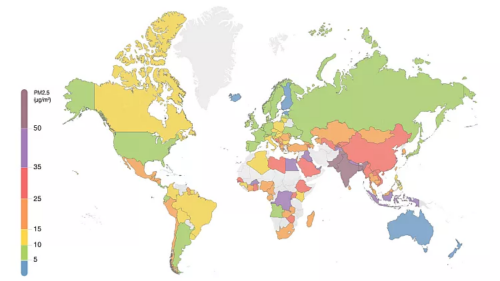Only seven countries in the world met safe air pollution levels in 2023, according to a report by Swiss air quality technology company IQAir.
The World Air Quality Report, released earlier this year, draws on data from more than 30,000 monitoring stations in 134 countries, territories and regions.
Of these, 124 were found to breach safe levels of PM2.5 (fine particulate matter), according to World Health Organization (WHO) guidelines.
These microscopic particles, measuring less than 2.5 microns in diameter, can be inhaled deep into our lungs and even reach our bloodstreams. They have been linked to heart and lung disease, high blood pressure, increased asthma risk, depression and anxiety, and premature death.
Which seven countries meet safe air quality levels?
The seven countries that met the safe guideline of five micrograms per cubic metre of air (µg/m3) or less were Australia, Estonia, Finland, Grenada, Iceland, Mauritius and New Zealand.
Puerto Rico, Bermuda and French Polynesia also fell within safe levels.
In Europe, Iceland had the cleanest air, with 4µg/m3, followed by Estonia with 4.7µg/m3 and Finland with 4.9µg/m3.
A colour scale was used to indicate pollution levels, with many European countries falling in the green category, denoting levels up to double the safe standard.
Starting with the least polluted, these included Sweden, Ireland, Norway, Portugal, Liechtenstein, Denmark, United Kingdom, Andorra, Latvia, Ukraine, Netherlands, Luxembourg, Switzerland, Germany, Belgium, France, Austria, Spain and Russia.
European cities have shown improvement since the 2022 report, with 54 per cent classified green in 2023 compared with 39 per cent the year before.

How bad is the air pollution in other European countries?
In the yellow category – denoting pollution levels up to three times above the safe standard – European countries included Lithuania, the Czech Republic, Hungary, Malta, Slovakia, Bulgaria, Croatia, Poland, Cyprus, Slovenia and Italy.
Croatia showed the most progress in 2023 in lowering PM2.5 levels, with the annual average dropping more than 40 per cent compared to 2022. It has achieved this by increasing its use of renewables, which so far make up more than 31 per cent of the country’s energy mix – well above the EU average of 23 per cent.
Croatia has also introduced policies to phase out coal before 2033, reduce methane emissions by 30 per cent below 2020 levels by 2030, and end deforestation by 2030.
In the orange category – up to five times above safe levels – were Moldova, Romania, Albania, Greece, Turkiye, Serbia and Montenegro.
Bosnia and Herzegovina saw an 18 per cent decrease in PM2.5 levels in 2023 compared to 2022, but remains the most polluted country in the region, followed by North Macedonia – both of which fell in the red category with pollution levels over five times the safe standard.
Iğdır in Turkiye is Europe’s most polluted city, with PM2.5 levels over nine times the safe standard.




